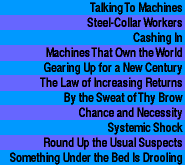


Steel-Collar Workers
In any one day, the United States Post Office handles roughly 500 million pieces of mail. A trained postal worker can sort eight hundred letters an hour, but a machine reader can sort five hundred zipcoded letters a minute. It can also work for twenty-four hours a day, not eight. So, at least for zipcoded letters, a machine can work about a hundred times faster than human sorters. Further, a decade from now its speed will probably quadruple while theirs will stay the same.By then, if America continues to prefer rapid postal service over continued postal worker employment, the Post Office may spend ten times as much money on automation as on new hires. Each automation dollar might be worth at least twenty dollars spent on employees. In 1991, the Post Office announced it would lay off almost fifty thousand employees by 1995 and replace them with machines---today's installment of an old story.
In 1846, Elias Howe, a Boston instrument maker, designed and built the first working model of a lockstitch sewing machine. Howe, nearly penniless at the time, had slaved for three years to build his machine. When it was finally finished, he gave a public showing where he decisively beat five seamstresses by sewing 250 stitches a minute. He and his partners then sat back and waited for the orders to roll in. There were none.
Boston's tailors gave many reasons: seamstresses would lose their livelihoods; the machine couldn't do everything a tailor could do; and it was expensive. Like the fifteenth-century scribes hearing of the printing press and the eighteenth-century weavers learning about the mechanical loom, these nineteenth-century tailors feared the machine would eat their jobs.
They were right. For if one person and a machine can make more suits than fifty trained tailors can, what's a tailor for? But despite the reaction of Boston's tailors, when the sewing machine was introduced to Britain and America, huge newspaper headlines proclaimed it the greatest invention of the age. It became the first real domestic machine.
The early machines were complicated and frequently broke down. They were also overdesigned and overornamented in a misguided attempt to appeal to the sensibilities of nineteenth-century housewives. Simplification and improvement to make them cheaper, more reliable, and more durable took roughly forty years. Finally, near the turn of the century, sewing machines grew good enough and cheap enough for garment manufacturers, envious of the immense automation already evident in the textile industry, to introduce them onto the factory floor. Thus were born the first modern sweatshops.
Today, it's not just blue-collar workers---from garment workers to fish canners, from lumber mill workers to auto workers---who should be thinking about their job's future. The computer is a universal information manipulator. It can follow any procedure we can explain clearly enough. So, it is also rapidly changing many white-collar jobs. Nowadays, advanced nations have many more white-collar employees than blue-collar workers, just as they have many more blue-collar workers than farmers. Once upon a time, they had mostly farmers. But the steam engine fixed that.